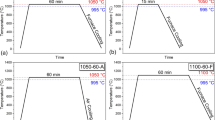Abstract
Electrolytic copper foil stands as a pivotal material in the electronics industry. Anode materials are extensively utilized in the processing of electrolytic copper foils. Given the intricate production conditions of copper foils, there are multifarious factors contributing to the failure of titanium anodes. Presently, there is comprehensive research into the failure mechanisms of titanium anodes under actual complex operational conditions. This paper addresses gaps by juxtaposing failed and new titanium anodes from a copper foil manufacturing facility. It analyzes the macroscopic and microscopic morphological alterations, elemental distribution, and phase composition changes in titanium anodes before and after failure. Additionally, by integrating performance tests such as CV and EIS, the study dissects the failure mechanism of commercially employed titanium anodes.












Similar content being viewed by others
Data Availability
The data that support the findings of this study are available from the corresponding author upon reasonable request. The data that support the findings of this study are available within the article [and its supplementary material].
References
Z. Dong, X. Fei, B. Gong et al., Effects of Deep Cryogenic Treatment on the Microstructure and Properties of Rolled Cu Foil. Materials. 14(19), 5498 (2021)
J. Zhang, D. Zuo, X. Pei et al., Effects of Electrolytic Copper Foil Roughness on Lithium-Ion Battery Performance. Metals. 12(12), 2110 (2022)
X. Tan, Z. Zheng, B. Peng et al., Simultaneous Degradation of p-Nitrophenol and Recovery of Copper from Wastewater in Electrochemical Reactor Under High Salinity. Sci. Adv. Mater. 13(12), 2450–2459 (2021)
X.L. Ma, Y.Z. Li, E.D. Yao et al., Microstructure and Properties of Electrolytic Copper Foil with Different Thicknesses. Rare Met. Mater. Eng. 48(9), 2905–2909 (2019)
W. Yu, C. Lin, Q. Li et al., A novel strategy to electrodeposit high-quality copper foils using composite additive and pulse superimposed on direct current. J. Appl. Electrochem. 51(3), 489–501 (2021)
J. Chen, X. Wang, H. Gao et al., Rolled electrodeposited copper foil with modified surface morphology as anode current collector for high performance lithium-ion batteries. Surf. Coat. Technol. 66, 127–369 (2021)
S.F. Mirseyed, K. Jafarzadeh, A. Rostamian et al., A novel approach to the role of iridium and titanium oxide in deactivation mechanisms of a Ti/(36 RuO2-x IrO2-(64–x) TiO2) coating in sodium chloride solution. Corros. Sci. 206, 110481 (2022)
Y. Zhang, Q. Ma, K. Feng et al., Effects of microstructure and electrochemical properties of Ti/IrO2-SnO2–Ta2O5 as anodes on binder-free asymmetric supercapacitors with Ti/RuO2–NiO as cathodes. Ceram. Int. 46(11), 17640–17650 (2020)
D. Kumar, G.S. Kumar, Electrochemical oxidation of direct blue 86 dye using MMO coated Ti anode: modelling, kinetics and degradation pathway. Chem. Eng. Process. Process Intensif. 181, 103–111 (2022)
X. Li, S. Cheng, R. Xu et al., Structure-Activity Relationships of TiO2 nanoflower-coated Porous Ti Anodes in Electro-catazone process. Chem. Eng. J. Adv. 11, 100347 (2022)
D. Ma, V. Ngo, S. Raghavan, Degradation of Ir–Ta oxide coated Ti anodes in sulfuric acid solutions containing fluoride. Corros. Sci. 164, 108358 (2020)
W. Xu, G.M. Haarberg, F. Seland et al., The durability of the thermally decomposed IrO2-Ta2O5 coated titanium anode in a sulfate solution. Corros. Sci. J. Environ. Degrad. Mater. Control. 150, 76–90 (2019)
S. Luo, H. Guo, Z. Wang et al., The Electrochemical Performance and Reaction Mechanism of Coated Titanium Anodes for Manganese Electrowinning. J. Electrochem. Soc. 166(14), 1071914 (2019)
F. Mo, Q. Zhou, Z. Hou et al., Efficient electro-catalyzed PMS activation on a Fe-ZIF-8 based BTNAs/Ti anode: An in-depth investigation on anodic catalytic behavior. Environ. Int. 169, 107548 (2022)
W. Huang, H. Xu, Z. Ying et al., Split TiO2 nanotubes—evidence of oxygen evolution during Ti anodization. Electrochem. Commun. 106, 106532 (2019)
W. Bömicke, P. Rammelsberg, G. Spatola et al., The effect of titanium anodization on the bond strength of 10-methacryloyloxydecyl dihydrogen phosphate (10-MDP) resin cement. Int. J. Prosthodont. 6, 66 (2022)
P. Weeranoppanant, M. Palanuwech, Effects of ceramic thickness and titanium anodization on esthetic outcomes of lithium disilicate ceramic over titanium alloys. Eur. J. Prosthodont. Restor. Dent. 31(1), 40–49 (2022)
J. Zhao, Z. Chi, H. Dong et al., Degradation of desphenyl chloridazon in a novel synergetic electrocatalytic system with Ni–Sb–SnO2/Ti anode and PEDOT/PSS-CNTs modified air diffusion cathode. J. Clean. Prod. 300, 126961 (2021)
W. Qian, M. Chen, J. Zhang et al., High efficiency toluene electrooxidation at gas-solid interface on Nafion-modified SnO2-Sb/Ti anode. Appl. Catal. B. 325, 122322 (2023)
W. Yaye, P. Randall, S. Huanhuan et al., Electrochemical degradation of perfluoroalkyl acids by titanium suboxide anodes. Environ. Sci. Water Res. Technol. 6(1), 144–152 (2020)
F. Yao, Q. Yang, Y. Zhong et al., Indirect electrochemical reduction of nitrate in water using zero-valent titanium anode: Factors, kinetics, and mechanism. Water Res. 157, 191–200 (2019)
X. Jiao, H. Jiao, H. Xu et al., Analysis of scale formation on oxide-coated titanium anode for manufacturing of electrolytic copper foils and corresponding maintenance methods. Electroplast. Finish. 38(1), 14–19 (2019)
Acknowledgments
This work is supported by the key research and development project of Shaanxi Province (Grant No. 2021SF-469), and the National Natural Science Foundation of China (Grant No. 5 2175184).
Author information
Authors and Affiliations
Corresponding author
Additional information
Publisher's Note
Springer Nature remains neutral with regard to jurisdictional claims in published maps and institutional affiliations.
Rights and permissions
Springer Nature or its licensor (e.g. a society or other partner) holds exclusive rights to this article under a publishing agreement with the author(s) or other rightsholder(s); author self-archiving of the accepted manuscript version of this article is solely governed by the terms of such publishing agreement and applicable law.
About this article
Cite this article
Zhang, J., Zhang, J., Cai, H. et al. Failure Mechanism Analysis of Titanium Anode for Electrolytic Copper Foils. J Fail. Anal. and Preven. 23, 2693–2708 (2023). https://doi.org/10.1007/s11668-023-01810-9
Received:
Accepted:
Published:
Issue Date:
DOI: https://doi.org/10.1007/s11668-023-01810-9




